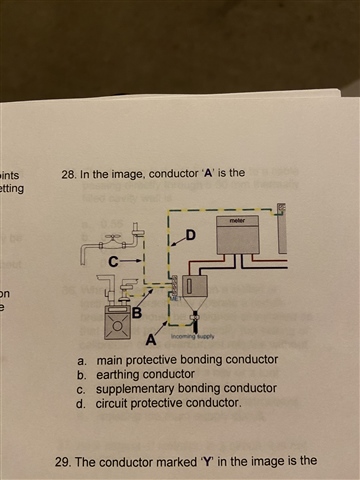 hi started to study for my 18th, wots you guys think the answer is, something tells me it’s different to wots on the answer sheet
hi started to study for my 18th, wots you guys think the answer is, something tells me it’s different to wots on the answer sheet
Thank you for the comments, I've always been told if you don't know the answer or you don't know how to do something is it stop at ask. I have worked with some if you ask answers or ask how to do something they will try and belittle you because they think you should now everything. it made me leave the industry for about 5 years, know I'm getting back into the industry again, and things have charged since then. I will be asking more questions.
CPC
Well, that would seem logical if you go with the fact that D can't be the earthing conductor ... It is a cpc if you take the view that it connects exposed-conductive-parts of both equipment on final circuits, and the consumer unit (if metal) to the MET.
So, it's a circuit protective conductor without a circuit of its own - or a cpc for all circuits (as this is the link to the MET).
Interesting.
Well, that would seem logical if you go with the fact that D can't be the earthing conductor ... It is a cpc if you take the view that it connects exposed-conductive-parts of both equipment on final circuits, and the consumer unit (if metal) to the MET.
So, it's a circuit protective conductor without a circuit of its own - or a cpc for all circuits (as this is the link to the MET).
This is why I suggested, "main protective conductor".
If it is a CPC, the circuit is the tails. Just because they are not bundled up into one cable does not change that.
However, what if the CU is 16th Edn or earlier and is plastic? There are no exposed CPs to be connected.
Thinking of a simple domestic installation with one DB, the CPCs are clearly part of each final circuit (whether the appliances are Class I or Class II). Looking at the definition of a CPC in Part 2, the final CPCs still have to be connected to the MET. If the MET is the earth terminal bar in the CU, we have no difficulty because D is the earthing conductor.
However, what if the installation serves two DBs, say one for the house and one for the garage? The MET is the terminal block where the earthing splits (just as the live conductors split in the Henley blocks). If you don't like "main protective conductor", how about "main circuit protective conductor"?
Of course it is, it provides the connection of the installation to Earth (provided b the cable sheath. The Installation is TN-S.
More interesting would be the name of the Link to the supply neutral in a TN-C-S installation. It should be G/Y and is again the Earthing conductor to the MET (one way or another)
If it is a CPC, the circuit is the tails.
The tails themselves may not need a cpc (if they are properly installed they meet the requirements of 412.2.4) ... but a metal CU does.
This is definitely the place to ask questions Andrew W There's some excellent and very knowledgeable people who hang out in here (you know who you are! ) that can answer any question you have on BS7671 Wiring Regulations.
If you have general questions relating to engineering or technology as a whole then pop them on our Engineering Discussions forum or anything career related over on our Career Development forum.
If you get stuck with using the forums or other areas of our EngX community then ask us a question or report an issue to us over on our dedicated Questions about IET EngX forum.
Hope that helps!
Lisa
We're about to take you to the IET registration website. Don't worry though, you'll be sent straight back to the community after completing the registration.
Continue to the IET registration site